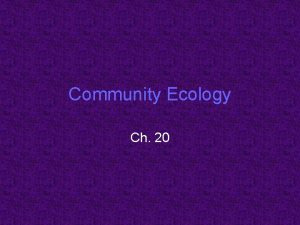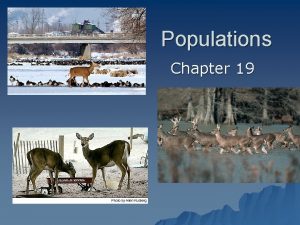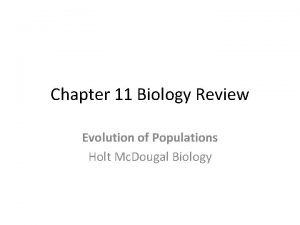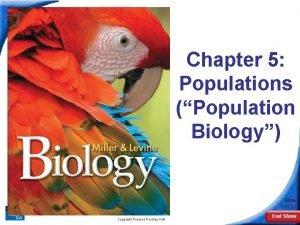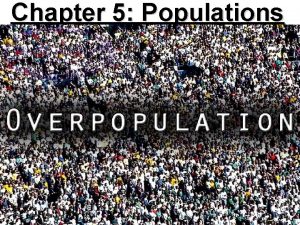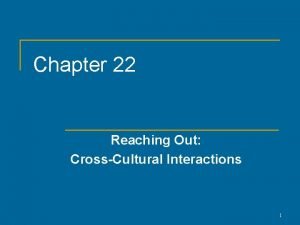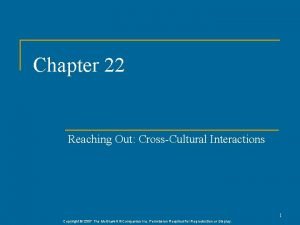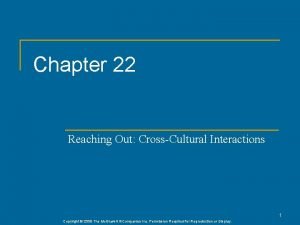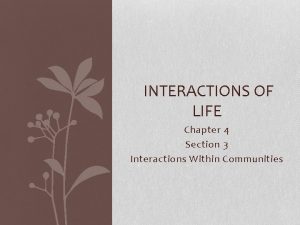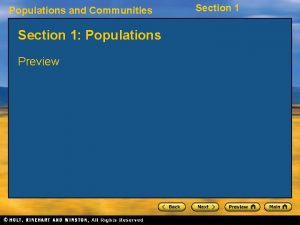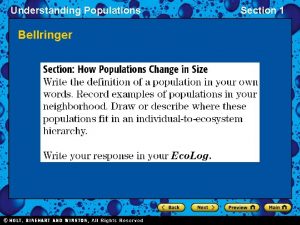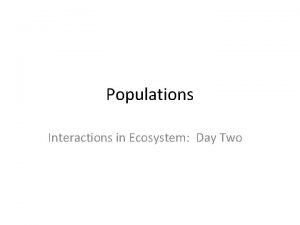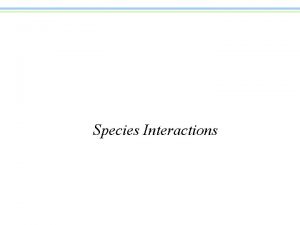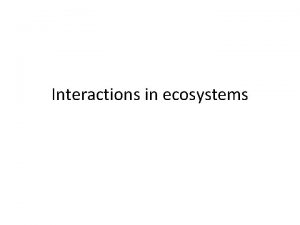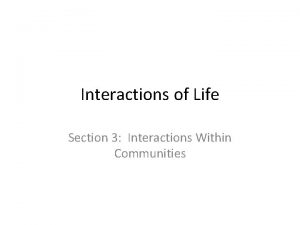INTERACTIONS OF LIFE Chapter 4 Section 2 Populations












- Slides: 12

INTERACTIONS OF LIFE Chapter 4 Section 2 Populations

Competition • Crickets need more food and hiding places as their population grows. – Food and Space • • • Organisms living in the wild do not always have enough food or living space. Woodpeckers must compete with each other for nesting spots. Competition occurs when 2 or more organisms seek the same resource at the same time.

– Growth Limits • Competition limits population size. • Competition for food, living space, or other resources can limit population growth. • Competition is most intense between the same species, because they need the same food and shelter. • Competition also takes place among different species.

Population Size • Ecologists measure the size of populations to see if the population is healthy and growing. • Help identify populations that could be in danger of disappearing. • Population density is the number of individuals of one species per a specific area.

– Measuring Populations • Ecologist face difficulties when trying to count populations. • One method is trap-mark-release. – Sample Counts • • Used by ecologists to estimate the sizes of large populations. To estimate how many rabbits are in 100 acres, find how many are in one, and multiply by 100.

– Limiting Factors • The availability of food, water, living space, mates, nesting sites, and other resources is often limited. • A Limiting factor is anything that restricts the number of individuals in a population. • Include living and nonliving features. • Can affect more than one population. • Example: Lack of rain fewer plants fewer seeds less food for mice less hawks and owls.

– Carrying Capacity • Carrying capacity is the largest number of individuals of one species that an ecosystem can support over time. • When a population exceeds the carrying capacity some individuals will not have enough resources, and will leave or even die.

– Biotic Potential • The highest rate of reproduction under ideal conditions is a populations biotic potential. • More offspring higher biotic potential for a species. • Avocado tree VS. Tangerine tree

Changes in Populations • Birthrates and death rates influence the size of a population. • If the number of births is greater than the number of deaths than the population is growing. • If the number of deaths is greater than the number of births, the population gets smaller. • 900 squirrels are born, 800 squirrels die, so the population is growing by 100.

– Moving Around • The movement of individuals can affect population size. • Mountain sheep moves to find a mate. • Birds migrate • Spores and seeds from plants are carried by the wind from place to place.

– Exponential Growth • Exponential growth means that the larger a population gets, the faster it grows. • Eventually a population will reach the carrying capacity. • As the population approaches the carrying capacity competition for resources increases.

Section 2 Questions 1. 2. 3. 4. 5. 6. 7. 8. 9. When does competition occur? What is population density? Population growth is limited by… Why do ecologists measure population size? How do ecologists measure populations? What is a limiting factor? What is carrying capacity? What is biotic potential? How do birthrates and death rates influence population size?
 Section 20-1 review species interactions
Section 20-1 review species interactions Evolution of populations section 16-1 genes and variation
Evolution of populations section 16-1 genes and variation Section 19-1 review understanding populations
Section 19-1 review understanding populations Section 5-3 human population growth
Section 5-3 human population growth Evolution of populations section 16-1 genes and variation
Evolution of populations section 16-1 genes and variation Evolution of populations section 11 review
Evolution of populations section 11 review 5.1 how populations grow
5.1 how populations grow Parasitism
Parasitism Chapter 22 reaching out cross-cultural interactions
Chapter 22 reaching out cross-cultural interactions Chapter 22 reaching out cross-cultural interactions
Chapter 22 reaching out cross-cultural interactions Chapter 22 reaching out cross-cultural interactions
Chapter 22 reaching out cross-cultural interactions 6.1 habitats, niches, and species interactions answer key
6.1 habitats, niches, and species interactions answer key Chapter 14 interactions in ecosystems
Chapter 14 interactions in ecosystems
